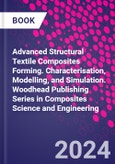Advanced Textile Structural Composites Forming: Characterisation, Modelling, and Simulation comprehensively describes the influence of fiber/fabric architectures and properties on composites forming, along with their deformability and structural optimization, covering the latest advances in the composites forming field. Part one reviews textile reinforcement architectures and discusses the forming behaviors of important 2D and 3D fabrics. Part two discusses numerical models to conduct simulation analysis of different structural composites forming at mesoscopic and macroscopic scales, in particular, 3D preforms with through-the-thickness yarns. Part three looks at the latest developments in the relationship between forming and other steps in composite manufacturing, such as resin injection, and automated fiber placement (AFP) and the effects on certain mechanical properties, such as structural damage and impact resistance. The book will be an essential reference for academic researchers, industrial engineers and materials scientists working with the manufacture and design of fiber-reinforced composite materials.
Table of Contents
Part I: Mechanical properties of textile reinforcements and their formability 1. Classification of fibre reinforcement architecture 2. Forming of the woven fabrics 3. Mechanical behaviours of the braided fabrics during the forming 4. Forming of Non Crimp Fabrics 5. Non-woven fabrics deformability 6. Robotic preforming of 3D fibre architectures 7. Formability of through-the-thickness tufted reinforcements 8. Forming of the natural fibers reinforcements 9. Thermoforming of thermoplastic preforms 10. Wrinkling behaviour and wrinkling mechanisms of the textile composites forming Part II: Forming modelling and simulations 11. Textile structural modelling for forming simulations 12. Forming simulations with mesoscopic approach 13. Forming simulations with macroscopic approach 14. Modelling and simulation of the 3D interlock weaving fabrics forming 15. Numerical simulation of the incremental forming of the textile reinforcements 16. Thermoforming modelling and simulation of textile thermoplastic prepregs Part III: Composite structural analysis taking into account forming 17. Textile composite damage analysis taking into account the preforming process 18. Stabbing and ballistic resistances of the pre-deformed multi-ply three-dimensional interlock fabrics 19. Influence of the preforming on the permeability/resin flow during the textile composites manufacturing 20. Forming of AFP (Automated Fiber Placement) material layups 21. Tailored Fiber Placement 22. Optimisation of forming process parameters using reinforcement learning
Authors
Peng Wang Professor, mechanical engineering, University of Haute-Alsace, France.Peng Wang is a Professor of mechanical engineering at ENSISA of the University of Haute-Alsace, France. His primary research interests and expertise encompass textile composites forming, mechanical properties of textile reinforcements and composites, structure optimization, and process simulation. He particularly focuses on optimizing the manufacturing process and improving the service performance of composites by thoroughly studying the deformation behavior during the forming process of fiber-reinforced preforms.
Nahi�ne Hamila Professor, Dupuy De Lome Research Institute, Brittany, France.. Nahi�ne Hamila is a Professor at the Dupuy De Lome Research Institute, Brittany, France. His research work focuses on modelling and simulation of composite material, and to this end he has developed constitute model models for dry or prepreg composite reinforcements in a multiphysics and multi-scale framework. The specificity of his work lies in the link he establishes between the manufacturing process and the properties induced on the behavior of structural parts and their durability.







